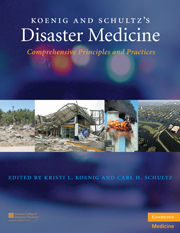Book contents
- Frontmatter
- Contents
- List of Contributors
- Contributor Biographies
- Foreword
- Preface
- Acknowledgments
- PART I CONCEPTUAL FRAMEWORK AND STRATEGIC OVERVIEW
- PART II OPERATIONAL ISSUES
- PART III CLINICAL MANAGEMENT
- SECTION A CBRNE AND HAZMAT
- 26 Explosive Events
- 27 Burn Patient Management
- 28 Clinical Aspects of Large-Scale Chemical Events
- 29 Biological Events
- 30 Nuclear and Radiological Events
- 31 Hazardous Material, Toxic, and Industrial Events
- SECTION B ENVIRONMENTAL EVENTS
- Index
- Plate section
- References
28 - Clinical Aspects of Large-Scale Chemical Events
from SECTION A - CBRNE AND HAZMAT
Published online by Cambridge University Press: 05 August 2011
- Frontmatter
- Contents
- List of Contributors
- Contributor Biographies
- Foreword
- Preface
- Acknowledgments
- PART I CONCEPTUAL FRAMEWORK AND STRATEGIC OVERVIEW
- PART II OPERATIONAL ISSUES
- PART III CLINICAL MANAGEMENT
- SECTION A CBRNE AND HAZMAT
- 26 Explosive Events
- 27 Burn Patient Management
- 28 Clinical Aspects of Large-Scale Chemical Events
- 29 Biological Events
- 30 Nuclear and Radiological Events
- 31 Hazardous Material, Toxic, and Industrial Events
- SECTION B ENVIRONMENTAL EVENTS
- Index
- Plate section
- References
Summary
INTRODUCTION
Since the dawn of civilization, chemical materials have been a part of human life. Today nearly 100,000 different commercial chemicals are known. Several thousand new chemicals are developed yearly. Of these new chemicals, nearly a thousand reach the commercial market. Annual worldwide chemical production is estimated at 400 million tons. Of this production, most is bulk stored and bulk transported. Hence there is a risk of large-scale release with resulting environmental and health effects. Human toxicity from chemical exposure has been well recorded since the beginning of the industrial age. Recognition and investigation of those effects have allowed the development of therapeutic interventions. Toxic effects of chemicals may result from exposures to small amounts such as present in foods or medications, or larger amounts resulting from accidental or intentional releases from storage or transportation facilities. The human toxic effects of smaller chemical exposure events have generally been well managed because there are rarely more than one or two patients requiring care at a time. Large-scale exposures vastly complicate the medical response to a toxic chemical event, principally because of overwhelming logistical difficulties. This chapter explores various clinical aspects of large-scale exposures to chemical agents. Several examples of both intentional (e.g., warfare or terrorist) and accidental events will be presented. Accompanying commentary will support the following central principles.
PRINCIPLES OF CHEMICAL EVENTS
1) The degree and speed of symptom onset results primarily from the amount of chemical incorporated (“dose response”) and secondarily, from the speed of chemical incorporation.
2) Much of the clinical information about toxic (warfare) chemical effects has been collected from studies of young, healthy military men. Extrapolation of those data to other subsets of the population (old, female, and persons with complicating medical illness, or concomitant use of medications) can be very difficult.
[…]
Keywords
- Type
- Chapter
- Information
- Koenig and Schultz's Disaster MedicineComprehensive Principles and Practices, pp. 430 - 453Publisher: Cambridge University PressPrint publication year: 2009
References
- 5
- Cited by



